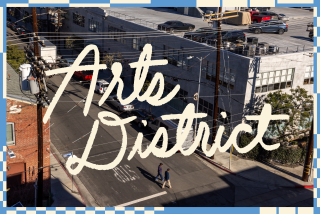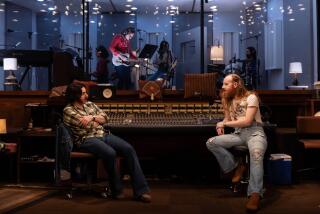Strolling Through New York’s Greenwich Village
- Share via
NEW YORK — Greenwich Village reigns as the epitome of Bohemianism. It’s all about high-voltage creativity and intellectualism, romance, sexuality and quaint Americana.
The allure of Greenwich Village, with its charming, one- and two-century-old buildings usually of three or four stories, overrides the changing fashions and fortunes of the rest of the city.
And ever since walking tours, mostly March through October, became popular here in the last two decades the village has ranked as the No. 1 destination.
By the late 18th Century the village began building its reputation as a melting pot for great and vivid minds.
Tom Paine, author of the Colonial-era “Common Sense,” lived here. A hundred years later dapper Mark Twain, a village resident--though beset by personal troubles--made a point of taking a Sunday stroll down Fifth Avenue when everyone else was coming out of church. He served as a beacon in his white suit amid the deacons in black.
Affordable Rents
At the turn of the century the village was one of the few neighborhoods with affordable rents for “French flats,” as apartments--a new, naughty living arrangement in former one-family houses, were called.
So Eugene O’Neill and other struggling writers moved in. Journalist John Reed repaired to a table in a popular village cafe and wrote “Ten Days That Shook The World.”
He couldn’t find space to work in his tiny apartment in a mew, a former stable, which he shared with his lover who eventually became his wife, Louise Bryant.
They belonged to a crowd that coaxed O’Neill out of a bar and locked him up to write “The Emperor Jones,” which established the Provincetown Playhouse as a power in theater.
Edna St. Vincent Millay was an impassioned poet and legendary lover in the village. Eventually she went to live in rural Woodstock, where she and her husband doused the flame with red wine, as an eminent professional guide to the village, Michael Levin, tells his walking-tour groups. But in her village period Millay added to the neighborhood’s reputation.
By the mid-20th Century villagers busied themselves with attaining landmark status, protecting it by law from demolition. Real estate values climbed.
Then the village suffered a brain drain of artists into SoHo, with its lower rents and larger spaces. But writers and musicians with rent-controlled apartments lingered on, and wealthy actors came to buy whole houses that cost $2 million to $5 million.
Public Commotion
Now the tranquil, manicured buildings puzzle those visitors who hope to stumble upon a wild party in the streets. And the visitors themselves cause most of the public commotion.
On weekends, particularly in spring and summer, groups ranging from baseball teams to school classes trail fast-stepping tour leaders through the narrow streets.
Village tours are conducted every weekend and sometimes on weekdays, except in the dead of winter. Private firms led by free-lance guides schedule custom-tailored tours, too.
Veteran guides script their own tours and deliver them with a theatrical flair. Although guides often cover similar territories, their lectures vary.
On his 90-minute Sunday tours Levin concentrates on Bohemian days, ghost stories indigenous to the village or literary figures and the history of the East Village, from former Dutch Gov. Peter Stuyvesant to the late pop art guru Andy Warhol. He does special tours, too.
Levin relates tales of other village standard-setters; one schoolteacher flouted convention by marrying, going without a corset, bobbing her hair, wearing ballet shoes and generally inventing the Bohemian village look.
Bursting Into Song
Arthur Marks, a city tour guide for more than 20 years, designed a series of tours for the New York Historical Society in 1987. His village tour, “Scholars and Sybarites,” is so popular that he had to hire seven assistants to lead groups.
With a breezy, outgoing style, Marks bursts into song along the way, singing Broadway tunes from plays about former Mayor Fiorello La Guardia and his predecessor, “Gentleman” Jimmy Walker. Both were born in the village.
Free-lancer Michael George, an architectural expert, leads tours through other Manhattan neighborhoods, including Gramercy Park and Morningside Heights, Wall Street, Brooklyn Heights and the downtown civic center near the historic district.
Guide Val Ginter, a Chicago native who fell in love with his father’s pictures and maps of New York City as a child, has his own firm, Ginter-Gotham Urban History. He gets up at 4 a.m. on tour days to polish his lectures, and sometimes leads all-day tours of East and West Village.
-- -- --
Most New York City walking tours cost about $10 per person, unless guides make special group arrangements.
Among the tour operators:
Michael Levin: (212) 924-7187.
Michael George: (212) 975-4114.
Arthur Marks, 24 Fifth Ave.: (212) 685-2761.
Ginter-Gotham Urban History: (212) 496-6859.
Pete Salwen, (212) 286-0320, leads a Mark Twain anniversary tour that usually takes place on Thanksgiving Day weekend.
The 92nd Street YMCA/YWCA: (212) 427-6000. The Y schedules tours of jazz and folk clubs in the heart of West Village.
The Municipal Art Society: (212) 935-3960.
Museum of the City of New York: (212) 534-1672.
Art Tours of Manhattan, (609) 683-0881, leads visits to museums, galleries, private lofts and studios in the Village, plus SoHo and other parts of New York City.
Doorway to Design, (212) 221-1111 and (718) 339-1542, arranges tours of village streets plus visits to private houses and creative firms.
More to Read
Sign up for The Wild
We’ll help you find the best places to hike, bike and run, as well as the perfect silent spots for meditation and yoga.
You may occasionally receive promotional content from the Los Angeles Times.






